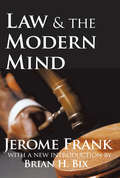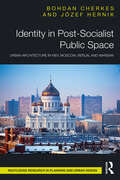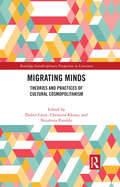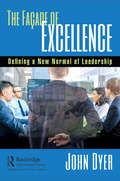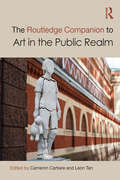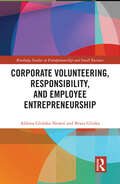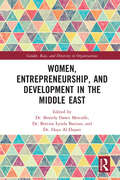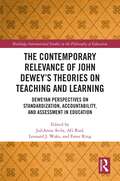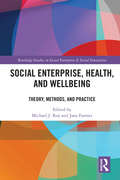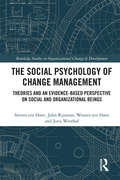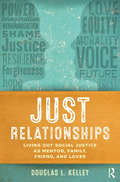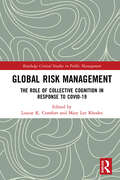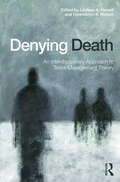- Table View
- List View
Indian Gold Jewellery Industry: Culture and Consumption (Routledge Focus on Management and Society)
by Sylvia RahaIndia has a long-standing cultural and societal affinity with gold and gold jewellery. Gold metaphorically represents the sacredness, purity and immortality that bind religious beliefs and culture together. Accumulation of gold is associated with material and non-material cultures where the perceptions, attitudes and experiences of the members engaged in production and consumption are bound into a complex relationship. The idea of the book initially originated from the course of research work. It was found that India has the largest unorganised jewellery industry, in terms of manufacturing and consumption unit. Jewellery fabrication in India is not just a profession for the jewellers, but it has been a family tradition extending across generations. Gold jewellery makers (sunnar, swarnakars) are the spine of the jewellery industry. They acquired the skill of making jewellery from the experienced and learned gold smithery (karigars), either from their ancestors who were engaged in this business or from the craftsmen-cum-petty traders. The co-relations of castes, religion, culture, economy and class are intertwined with each other in such a way that made the gold jewellery industry sustainable. Surprisingly, there is an absence of literature on understanding the structural and functional aspects of the gold jewellery industry in India.This book explores the roles of sunars/swarnakars (goldsmith or jewellery makers), consumers, trade and the policies that bring a change in the gold jewellery industry in India and India’s position in the global market scenario. By focusing on their way of life, the book brings unique insights into the social and economic experience of the unorganised gold jewellery sector and the role of consumers in production.
Indian Gold Jewellery Industry: Culture and Consumption (Routledge Focus on Management and Society)
by Sylvia RahaIndia has a long-standing cultural and societal affinity with gold and gold jewellery. Gold metaphorically represents the sacredness, purity and immortality that bind religious beliefs and culture together. Accumulation of gold is associated with material and non-material cultures where the perceptions, attitudes and experiences of the members engaged in production and consumption are bound into a complex relationship. The idea of the book initially originated from the course of research work. It was found that India has the largest unorganised jewellery industry, in terms of manufacturing and consumption unit. Jewellery fabrication in India is not just a profession for the jewellers, but it has been a family tradition extending across generations. Gold jewellery makers (sunnar, swarnakars) are the spine of the jewellery industry. They acquired the skill of making jewellery from the experienced and learned gold smithery (karigars), either from their ancestors who were engaged in this business or from the craftsmen-cum-petty traders. The co-relations of castes, religion, culture, economy and class are intertwined with each other in such a way that made the gold jewellery industry sustainable. Surprisingly, there is an absence of literature on understanding the structural and functional aspects of the gold jewellery industry in India.This book explores the roles of sunars/swarnakars (goldsmith or jewellery makers), consumers, trade and the policies that bring a change in the gold jewellery industry in India and India’s position in the global market scenario. By focusing on their way of life, the book brings unique insights into the social and economic experience of the unorganised gold jewellery sector and the role of consumers in production.
Law and the Modern Mind
by Jerome Frank Brian H. BixLaw and the Modern Mind first appeared in 1930 when, in the words of Judge Charles E. Clark, it "fell like a bomb on the legal world." In the generations since, its influence has grown-today it is accepted as a classic of general jurisprudence.The work is a bold and persuasive attack on the delusion that the law is a bastion of predictable and logical action. Jerome Frank's controversial thesis is that the decisions made by judge and jury are determined to an enormous extent by powerful, concealed, and highly idiosyncratic psychological prejudices that these decision-makers bring to the courtroom.
Identity in Post-Socialist Public Space: Urban Architecture in Kiev, Moscow, Berlin, and Warsaw (Routledge Research in Planning and Urban Design)
by Bohdan Cherkes Józef HernikThis book is a comparative analysis of the architecture of central public spaces of capital cities in Central and Eastern Europe during the period of their authoritarian and post-authoritarian development. It demonstrates that national identity transformations cause structural changes in urban public spaces, and theorises identity and national identity within urban planning in order to explain the influence of historical, cultural, mental, social as well as ideological and political conditions on the processes of shaping and perceiving the architecture of public space. The book addresses the process of shaping and restructuring historic centres of European capital cities of Kiev, Moscow, Berlin, and Warsaw, which developed under authoritarian regime conditions throughout the 20th century and were characterised by ideological determinism and the influence of state ideology and politics on the architecture of public spaces. The book will be useful for urban planners, architects, land management specialists, art historians, political scientists, and readers interested in the theory and history of cities, the fundamentals of urban planning and architecture, and the planning of cities and public spaces.
Migrating Minds: Theories and Practices of Cultural Cosmopolitanism (Routledge Interdisciplinary Perspectives on Literature)
by Didier CosteAwarded the 2023 "René Wellek Prize for the Best Edited Essay Collection" by the American Comparative Literature Association, Migrating Minds contributes to the prominent interdisciplinary domain of Cosmopolitan Studies with 20 innovative essays by humanities scholars from all over the world that re-examine theories and practices of cosmopolitanism from a variety of perspectives. The volume satisfies the need for a stronger involvement of Comparative and World Literatures and Cultures, Translation, and Education Theories in this crucial debate, and also proposes an experimental way to explore in depth the necessity of a cosmopolitan method as well as the riches of cosmopolitan representations.The essays follow a logical progression from the situated philosophical and political foundations of the debate to interdisciplinary propositions for a pedagogy of cosmopolitanism through studies of modern and contemporary cosmopolitan cultural practices in literature and the arts and the concurrent analysis of prototypes of cosmopolitan identities. This trajectory allows readers to appreciate new historical, theoretical, aesthetic, and practical implications of cosmopolitanism that pertain to multiple genres and media, under different modes of production and reception. In the deterritorialized landscape of Migrating Minds, mental and sentimental mobility, rather than the legacy of place, is the key to an efficient, humanist response to deadening globalization.
The Façade of Excellence: Defining a New Normal of Leadership
by John DyerThe crucial need to substitute true leadership for bad management practices such as Management By Objectives (MBO) and the use of fear is now well known and was often championed by Dr. W. Edwards Deming. While significant progress has been made, many organizations (especially outside of manufacturing) are either just getting started with their improvement efforts or they are faking their way forward (going through the motions), trying to imitate what they have read in books or have seen at conferences. The executives of these organizations might give permission for the tools of Lean and Six Sigma to be taught but many of them still refuse to look in a mirror and change their own leadership style. They have built a "façade of excellence" that crumbles quickly whenever a bit of chaos is introduced. Not being able to sustain improvements over the long term is one of the top complaints from improvement professionals. What ingredient is missing that prohibits changes to occur throughout the leadership ranks that might create a culture that embraces teamwork, collaboration and improvement? To start, what exactly do we mean by leadership? The common mistake is to try and put all effective leaders into the same box. Leadership actually has many dimensions and several definitions. This book explores four different styles of leadership that includes "The Crisis Leader," "The Idea Gathering Leader," "The Team Forming Leader," and "The Empowerment Leader."Each of the four styles is appropriate when given a certain set of circumstances (an organization in trouble needs a "Crisis Leader" for example). The goal is to shift the organization, including the leaders and all of the employees at every level, toward collaboration and empowerment. Why go through the pains to rebuild an organization’s culture and leaders? In the annual "IndustryWeek Magazine - Best Plants" competition, the companies that have made the transition to high performance, fully empowered teams ("The Empowerment Leader"), in general, demonstrate far better results than all other applicants (and they tend to win "Best Place to Work" awards as well).So, what is keeping organizational leaders, especially those in the middle of the organization chart, from adopting the "The Empowerment" leadership style? This book defines and helps the reader understand what this new normal of leadership consists of and: Explains the four different styles of leaders and how these are different than a typical "old style" manager. Indicates which style is appropriate given a certain set of circumstances and how a leader knows when it is time to migrate from one style to another. Illustrates what it means for an organization to shift from a "dictator" culture to one of collaboration and what steps can be taken to help this transformation. Explores the current definition of a "promotable manager" and how this differs from a new normal definition of an outstanding, effective "Empowerment" leader. Defines Mission, Vision, Strategy, and Values and how these four cultural principles fit into the leadership progression model. Shows how the culture within the organization will be different after the adoption of empowered teams and introduces the concept of "Enthusiastic Productivity."
The Routledge Companion to Art in the Public Realm (Routledge Art History and Visual Studies Companions)
by Cameron Cartiere Leon TanThis multidisciplinary companion offers a comprehensive overview of the global arena of public art.It is organised around four distinct topics: activation, social justice, memory and identity, and ecology, with a final chapter mapping significant works of public and social practice art around the world between 2008 and 2018. The thematic approach brings into view similarities and differences in the recent globalisation of public art practices, while the multidisciplinary emphasis allows for a consideration of the complex outcomes and consequences of such practices, as they engage different disciplines and communities and affect a diversity of audiences beyond the existing 'art world'. The book will highlight an international selection of artist projects that illustrate the themes.This book will be of interest to scholars in contemporary art, art history, urban studies, and museum studies.
This Happened Here: Amerikaners, Neoliberals, and the Trumping of America
by Paul StreetThis book examines the Trump phenomenon and presidency as fascist. Fascism here connotes not generically "bad" politics or a consolidated political-economic regime (Mussolini’s Italy or Hitler’s Germany) but a set of political, movement, and ideological traits understood within the context of the neoliberal-capitalist era. While Trump’s election defeat is a respite, the nation is far from out of the neofascist woods. Defeating the menace will require political and societal restructuring far beyond what is imagined by Democrats. This argument is developed across seven chapters that recount Trump’s assault on the 2020 election, specifically define the meaning of fascism as it is used in this book, demonstrate the neofascist nature of the Trump presidency, engage intellectual class Trumpism-fascism-denial, analyze the Trump base, root Trumpism in a longstanding and indeed founding American white nationalism, examine why Trump rose to power when he did, and suggest paths for fascism-proofing the USA.
Corporate Volunteering, Responsibility and Employee Entrepreneurship (Routledge Studies in Entrepreneurship and Small Business)
by Aldona Glińska-Neweś Beata GlinkaSupporting employee entrepreneurship is among major challenges contemporary organizations face. Many facets of corporate entrepreneurship are investigated, and the body of knowledge in the field is growing rapidly; nevertheless, there are still knowledge and research gaps to be filled. Notably, while there are studies linking HRM with corporate entrepreneurship, studies on connections between CSR-oriented practices and corporate/employee entrepreneurship are to be developed.The main goal of this book is to explain relationships between corporate volunteering and employee entrepreneurship in organisations. The book combines two extremely vivid fields of research: entrepreneurship and corporate social responsibility. Based on their own research, the authors present how participation in corporate volunteering, as one of the CSR practices in organisations, leads to strengthening employee entrepreneurial behaviour. The book offers a framework showing the role of CSR practices in shaping entrepreneurial and innovative employees’ behaviour.This book is aimed mainly at postgraduates, researchers and academics in the fields of entrepreneurship and corporate volunteering. As it touches vital fields of managerial education and management, it will also be of interest to master level students at universities or business schools as well as business practitioners.
Women, Entrepreneurship and Development in the Middle East (Gender, Race, and Diversity in Organizations)
by Beverly Dawn MetcalfeThe Middle East was the region least impacted in the 2008 crisis, has investment systems markedly different to the West, is largely governed by Islamic Shari’a, and has varying forms of governance and institutional organization, which are not understood by many, nor how these systems shape entrepreneurial and industrial development. While the Middle East as a region has seen a small growth in entrepreneurship for women, and business scholarship on the Middle East has grown, there is no text in English that has brought critical insights from the Middle East together in a single volume. In examining women’s entrepreneurship in the Middle East, this book aims to challenge Global North assumptions about the disempowering impacts of Islamic Shari’a and governance. Referring to the constraints of Islam on women’s subjectivity and agency greatly misunderstands religious identity, of both men and women, and the way in which public administration and private sector institutions are organized in very different ways to Western regions. This timely text expands and adds new insights to the theorizations of women’s entrepreneurship in the Middle East, through unravelling spatialized themes, and incorporates contemporary themes including: an Islamic science reading of women, work and venturing; changing families and entrepreneurship development; women managing social crises; Islamization, governance and women; Islamic feminist activisms and entrepreneurship; representations of women’s entrepreneurship on social media; and women’s collectives leading entrepreneurship via Facebook entrepreneurship. It will be of interest to researchers, academics, and students in the fields of entrepreneurship, gender, work and organizations.
Hegel and the Frankfurt School (Routledge Studies in Nineteenth-Century Philosophy)
by Paul GiladiThis collection of original essays discusses the relationship between Hegel and the Frankfurt School Critical Theory tradition. The book’s aim is to take stock of this fascinating, complex, and complicated relationship. The volume is divided into five parts: Part I focuses on dialectics and antagonisms. Part II is concerned with ethical life and intersubjectivity. Part III is devoted to the logico-metaphysical discourse surrounding emancipation. Part IV analyses social freedom in relation to emancipation. Part V discusses classical and contemporary political philosophy in relation to Hegel and the Frankfurt School, as well as radical-democratic models and the outline and functions of economic institutions.
Corporate Social Responsibility and Governance: Stakeholders, Management and Organizational Performance in the European Union (Routledge Studies in Corporate Governance)
by Panagiotis Dimitropoulos Efthalia Elia ChatzigianniCorporate social responsibility (CSR) has developed into a crucial corporate and organizational issue around the world. It has been incorporated into various sectors and countries, and includes many types of activities and dimensions. It is a common notion that organizations are more inclined today to broaden and shift their performance focus from short-term goals towards long-term social, environmental, and value-added perspectives.Under the framework of corporate governance, organizations and companies are motivated to promote fairness, transparency, ethics, and accountability in their transactions, while concurrently maintaining enhanced standards of governance. This means that organizations and corporations must align their activities with community aspirations which is an issue falling within the sphere of CSR. Increased attention has been placed on the organizations regarding their approach towards the needs of various stakeholders. However, a crucial issue that this book attempts to address is the association, intersection, and inter-relationship between governance and CSR within the EU region, which are not adequately established in the existing literature. The book will show that governance and CSR are highly connected. With the purpose of studying the association of CSR with legal, managerial and empirical aspects of governance in corporations and not-for-profit organizations, in various sectors of the economy, the book also intends to provide useful policy implications, as well as to offer constructive directions for future research. This book will be of value to researchers, academics, practitioners, policymakers, and students in the fields of CRS and governance, organizational theory, marketing management, business ethics and human resource management.
Human Performance Improvement through Human Error Prevention: A Comprehensive Implementation Guide for Protecting Employees and Maintaining Cost Efficiency
by BW (Ben) MarguglioThis book is a simulation of a live course on human performance improvement/human error prevention (HPI/HEP) created by the preeminent authority on HPI/HEP. It presents the greatest breadth of scope and specificity on this topic. This book comprises a focused, challenging human error prevention training course designed to improve understanding of error causation. It will dramatically reduce human error and repeat deviations, and it digs below the surface of issues and looks to fix the real causes of human error and mistakes. In addition, this book presents a complete seminar from the thought leader acclaimed by hundreds of clients, and includes unique principles, practices, models, and templates. Information is comprehensive and can be directly implemented. The principles and practices of human error prevention are universally applicable regardless of the type of industrial, commercial, or governmental enterprise, and regardless of the type of function performed within the enterprise. The application of the information in this book will significantly contribute to improved productivity, safety, and quality. After fully using this book, you will understand: Human error prevention/reduction terminology and definitions. The relationships among culture, beliefs, values, attitudes, behavior, results, and performance. The roles of leadership in establishing and maintaining a quality/safety-conscious work environment. The one fundamental precept explaining the importance of human error prevention/reduction. The two most critical elements of human error prevention/reduction. The three levels of barriers to human error. The four types of things in which the barriers may exist at each barrier level. The five stages of human error. The six "M"s that can emit or receive hazards activated by human error. The seven universally applicable human error causal factors. The Rule of 8 by which to prevent human error and mitigate its effects. Techniques for making barriers effective and the spectrum of barrier effectiveness. The relationship of human error prevention/reduction to the total quality/safety function. Error-inducing conditions (error traps) and behaviors for counteracting these conditions. Non-conservative and conservative thought processes and behaviors in decision-making. Coaching for preventing the recurrence of human error. Root cause analysis techniques for identifying human error causal factors. The nine types of corrective action. Human error measurement. Strategies for a human error prevention/reduction initiative. How to design, implement, and manage a human error prevention/reduction initiative.
The Contemporary Relevance of John Dewey’s Theories on Teaching and Learning: Deweyan Perspectives on Standardization, Accountability, and Assessment in Education (Routledge International Studies in the Philosophy of Education)
by JuliAnna ÁvilaThrough expert analysis, this text proves that John Dewey’s views on efficiency in education are as relevant as ever. By exploring Deweyan theories of teaching and learning, the volume illustrates how they can aid educators in navigating the theoretical and practical implications of accountability, standardization, and assessment. The Contemporary Relevance of John Dewey’s Theories on Teaching and Learning deconstructs issues regarding accountability mechanisms, uniform assessment systems, and standardization processes through a Deweyan lens. Connecting the zeitgeist of the era from which Dewey’s ideas emerged and current global political, social, and economic contexts, the book emphasizes the importance of resilient systems in reconciliating the tension between standardized assessments and individual student development. Contributors provide insights from a range of settings across Pre-K, primary, secondary, and higher education and address topics including teacher agency, voice, leadership, and democracy.The volume will be of interest to scholars, researchers, and academics with an interest in philosophy of education, education policy and the impact of neoliberal agendas, as well as teaching and learning more broadly.
Social Enterprise, Health, and Wellbeing: Theory, Methods, and Practice (Routledge Studies in Social Enterprise & Social Innovation)
by Michael Roy Jane FarmerIn recent decades, governments have promoted social enterprise as a means to address welfare and tackle disadvantage. Early academic work on social enterprises reflected this development and engaged with their ability to deliver and create jobs, work towards remedial environmental goals, and address a range of societal challenges. More recently, researchers have started to investigate the broader potential of social enterprise for the wellbeing of people and the planet.In this context, this book aims to answer the question: In what ways can social enterprises improve the health and wellbeing of individuals and communities? The chapters in this edited collection take different perspectives on assessing how social enterprises address disadvantage and deliver health and wellbeing impacts. Drawing on evidence from international research studies, Social Enterprise, Health, and Wellbeing: Theory, Methods, and Practice presents the ‘first wave’ of innovative research on this topic and provides a platform of evidence to inspire the next generation of scholarly and policy interest. Drawing on the cutting edge of interdisciplinary research in the field, this book will be of interest to researchers, academics, policymakers, and students in the fields of entrepreneurship, public and social policy, community development, public health, human geography, and urban planning.
Virtual Reality and Virtual Environments: A Tool for Improving Occupational Safety and Health (Occupational Safety, Health, and Ergonomics)
by Andrzej GrabowskiVirtual reality (VR) techniques are becoming increasingly popular. The use of computer modeling and visualization is no longer uncommon in the area of ergonomics and occupational health and safety. This book explains how studies conducted in a simulated virtual world are making it possible to test new solutions for designed workstations, offering a high degree of ease for introducing modifications and eliminating risk and work-related accidents. Virtual reality techniques offer a wide range of possibilities including increasing the cognitive abilities of the elderly, adapting workstations for people with disabilities and special needs, and remote control of machines using collaborative robots.Detailed discussions include: Testing protective devices, safety systems, and the numerical reconstruction of work accidents Using computer simulation in generic virtual environments On the one hand, it is a self-study book made so by well-crafted and numerous examples. On the other hand, through a detailed analysis of the virtual reality from a point of view of work safety and ergonomics and health improvement. Ewa Grabska, Jagiellonian University, Kraków, PolandNoteworthy is the broad scope and diversity of the addressed problems, ranging from training employees using VR environments with different degrees of perceived reality; training and rehabilitation of the elderly; to designing, testing, modifying, and adapting workplaces to various needs including those of disabled workers; to simulation and investigation of the cause of accidents at a workplace.Andrzej Krawiecki, Warsaw University of Technology, Warsaw, Poland
The Latest Illustrated Book of Development Definitions
by Carl G. LindbloomIllustrated definitions are rarely found in zoning and development ordinances. Ordinances prefer the "thousand words" rather than the "single picture." Illustrations greatly simplify how standards should be applied, particularly where the lot or parcel is irregularly shaped or where there are a number of variables present, each of which might have an impact on how the ordinance might apply in a specific situation. This best-selling resource has been the mainstay of the planner's bookshelf since its first publication and it differs from other books and publications containing development definitions in three major respects: It is illustrated; most of the definitions are designed to be used directly in ordinances with little or no change; and the more complex definitions are accompanied by commentaries and annotations that explain how the definition may be used in an ordinance, along with background information pertinent to the definition. This expanded edition standardizes in one handy reference all the key terms used in zoning, subdivision, site plan, and environmental ordinances. In all, it contains 1,957 definitions and 103 illustrations that can be incorporated in local ordinances with little or no change. Written and illustrated by two professional planners with nearly eighty years of combined experience in the practice of planning and zoning, this is a basic working tool and required reference for anyone involved in land development planning and regulation.
The Lean IT Field Guide: A Roadmap for Your Transformation
by Michael A. Orzen Thomas A. PaiderHow many IT books have you read that are long on theory and short on practical application? They are interesting, but not very impactful. They provide a framework from which to think and understand, but lack a process from which to act. Addressing this urgent need for the IT community, The Lean IT Field Guide explains how to initiate, execute, and sustain a lean IT transformation.Illuminating a clear path to lean IT, the authors integrate more than two decades of combined experience to provide you with a proven method for creating and sustaining a true lean IT workplace. This field guide not only highlights the organizational techniques of more agile and lean processes, but also the leadership work required to help management adopt these new approaches.Based on proven methods from different industries, including banking, manufacturing, insurance, food and beverage, and logistics, the book details a clear model that covers all the components you need to achieve and sustain a favorable work environment and culture in support of lean IT.Filled with anecdotes and case studies from actual businesses, the book includes pictures, templates, and examples that illustrate the application of the lean methods discussed.
Understanding Employee Engagement: Theory, Research, and Practice (Applied Psychology Series)
by Zinta S. ByrneUnderstanding Employee Engagement is a comprehensive source for the science and practice of employee engagement. This book provides a rigorous and objective review of scholarship and empirical research on engagement from around the world. Grounded in theory and empirical research, this book debates the definitions of engagement, provides a thorough evaluation of empirical findings in the engagement field including a focus on international findings, and offers practice implications for organizations. The book is broad, with references and research across disciplines and countries, as well as new sections addressing current challenges, such as virtual engagement, engaging the aging workforce, and perspectives on diversity and inclusion. Employers can learn how to foster an engaged organization; practitioners can learn how to measure, identify, and implement evidence-based solutions to disengagement; and researchers can master the existing engagement literature and begin to study the many propositions and new models the author proposes throughout the book. This book is an essential read for scholars, researchers, practitioners, and business leaders alike for understanding how to measure, identify, and implement evidence-based solutions to foster employee engagement.
Common Data Sense for Professionals: A Process-Oriented Approach for Data-Science Projects
by Rajesh JugulumData is an intrinsic part of our daily lives. Everything we do is a data point. Many of these data points are recorded with the intent to help us lead more efficient lives. We have apps that track our workouts, sleep, food intake, and personal finance. We use the data to make changes to our lives based on goals we have set for ourselves. Businesses use vast collections of data to determine strategy and marketing. Data scientists take data, analyze it, and create models to help solve problems. You may have heard of companies having data management teams or chief information officers (CIOs) or chief data officers (CDOs), etc. They are all people who work with data, but their function is more related to vetting data and preparing it for use by data scientists. The jump from personal data usage for self-betterment to mass data analysis for business process improvement often feels bigger to us than it is. In turn, we often think big data analysis requires tools held only by advanced degree holders. Although advanced degrees are certainly valuable, this book illustrates how it is not a requirement to adequately run a data science project. Because we are all already data users, with some simple strategies and exposure to basic analytical software programs, anyone who has the proper tools and determination can solve data science problems. The process presented in this book will help empower individuals to work on and solve data-related challenges. The goal of this book is to provide a step-by-step guide to the data science process so that you can feel confident in leading your own data science project. To aid with clarity and understanding, the author presents a fictional restaurant chain to use as a case study, illustrating how the various topics discussed can be applied. Essentially, this book helps traditional businesspeople solve data-related problems on their own without any hesitation or fear. The powerful methods are presented in the form of conversations, examples, and case studies. The conversational style is engaging and provides clarity.
The Social Psychology of Change Management: Theories and an Evidence-Based Perspective on Social and Organizational Beings (Routledge Studies in Organizational Change & Development)
by Steven ten Have John Rijsman Wouter ten Have Joris WesthofChanges are rarely accomplished by individuals. People are social animals and changes are social processes which have to be organized. Social psychology is essential for the effectiveness and development of the field of change management. It is necessary to understand people in change processes. Social psychology also teaches us that meaning is key during change and intervention. Social psychology makes change management comprehensible to people and allows them to consider their actions in groups and the organization on their merits. They may seem obvious and self-evident, but practice and science, as well as the popular change management literature, show that it is not.Drawing on the field of social psychology and based on primary research, The Social Psychology of Change Management presents more than forty social psychological theories and concepts that are relevant for the field of change management. The theories and concepts are analyzed and categorized following Fiske’s five core social motives; belonging, understanding, controlling, enhancing self, and trusting. Each theory will have an introduction in which its assumptions and relevance is explained.By studying the scientific evidence, including meta-analytic evidence, the book provides practitioners, students and academics in the field of change management, organizational behaviour and business strategy the most relevant social psychological ideas and best available evidence, thereby further unleashing the potential of social psychology in order to feed the field of change management. By categorizing and integrating the relevant theories and concepts, change management is enriched and restructured in a prudent, positive and practical way. The overarching goal, however, inspired by the ideas and perspective of leading thinkers like Kurt Lewin, James Q. Wilson and Susan T. Fiske, is to make the world a better place. Social psychologists (being social scientists) study practical social issues, in our case issues related to change management, and application to real-world problems is a key goal. Therefore, this book goes beyond the domain of organizational sciences.
Just Relationships: Living Out Social Justice as Mentor, Family, Friend, and Lover
by Douglas L. KelleyBringing a social justice lens to daily interpersonal relationships, Just Relationships offers a perspective on existing social science theory that demonstrates how our personal relationships should be grounded in fairness and justice. Douglas Kelley utilizes concepts from a variety of academic disciplines and helping professions to examine the barriers encountered in achieving balanced partnerships. This student-friendly book brings the important new perspective of social justice to courses focusing on interpersonal relationships and family relationships, supplementing traditional textbooks. This book presents key relationship theories in each chapter and then applies them from a social justice perspective; uses thought-provoking case studies and guiding questions to enhance student learning; examines a number of different types of interpersonal relationships including family, friends, lovers, and mentor-mentee relationships within a variety of socioeconomic and sociocultural contexts.
Global Risk Management: The Role of Collective Cognition in Response to COVID-19 (ISSN)
by Louise K. Comfort Mary Lee RhodesThe rise and spread of Covid-19 in the beginning of 2020 presents a once-in-a-century challenge and opportunity for decision makers, managers, scholars, and citizens to understand the risks, mitigate its impact and prepare for future crises. Drawing on a global network of scholars, this book presents a comparative analysis of ten nations’ response to a global pandemic, while operating nominally under the framework of the World Health Organization. The book introduces the concept of ‘collective cognition’ as an analytic lens for examining the nations’ response to Covid-19 during the first six months of the emerging pandemic (January – June 2020) and draws out insights for improving systems of global risk management. This book addresses four primary audiences: policy-makers and leaders in nations struggling to contain viruses while guiding their societies under threat; academic researchers, students, and educators engaged in preparing the next generation of professionals committed to investigating emerging risk: managers of non-profit and private organizations that operate and maintain the networks of social, technical, and economic services that are essential to functioning communities; and the informed general public interested in understanding this extraordinary sequence of events and in managing the novel risk of COVID-19 in a more informed, responsible way.
Denying Death: An Interdisciplinary Approach to Terror Management Theory (The\enlightenment World Ser. #11)
by Lindsey A. Harvell Gwendelyn S. NisbettThis volume is the first to showcase the interdisciplinary nature of Terror Management Theory, providing a detailed overview of how rich and diverse the field has become since the late 1980s, and where it is going in the future. It offers perspectives from psychology, political science, communication, health, sociology, business, marketing and cultural studies, among others, and in the process reveals how our existential ponderings permeate our behavior in almost every area of our lives. It will interest a wide range of upper-level students and researchers who want an overview of past and current TMT research and how it may be applied to their own research interests.
Developing Trauma-Responsive Approaches to Student Discipline: A Guide to Trauma-Informed Practice in PreK-12 Schools (Routledge Research in Education)
by Kirk Eggleston Erinn J. Green Shawn Abel Stephanie Poe Charol ShakeshaftBuilding on comprehensive research conducted in US schools, this accessible volume offers an effective model of school leadership to develop and implement school-wide, trauma-responsive approaches to student discipline.Recognizing that challenging student behaviours are often rooted in early experiences of trauma, the volume builds on a model from the Substance Abuse and Mental Health Services Administration (SAMHSA) to walk readers through the processes of realizing, recognizing, responding to, and resisting the impacts of trauma in school contexts. Research and interviews model an educational reform process and explain how a range of differentiated interventions including Positive Behaviour Interventions and Supports (PBIS), social-emotional learning (SEL), restorative justice, and family engagement can be used to boost student resilience and pro-social behaviour. Practical steps are supported by current theory, resources, and stories of implementation from superintendents, principals, and teachers. This text will benefit school leaders, teachers, and counsellors with an interest in restorative student discipline, emotional and behavioural difficulties in young people, and PreK-12 education more broadly. Those interested in school psychology, trauma studies, and trauma counselling with children and adolescents will also benefit from the volume.

